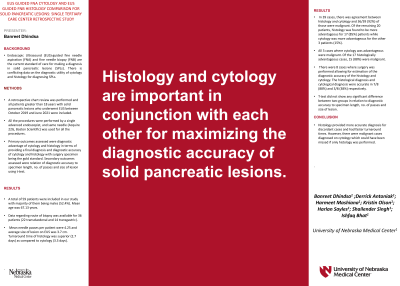Back


Poster Session B - Monday Morning
Category: Biliary/Pancreas
B0016 - EUS-Guided FNA Cytology and EUS-Guided FNB Histology Comparison for Solid Pancreatic Lesions: Single Tertiary Care Center Retrospective Study
Monday, October 24, 2022
10:00 AM – 12:00 PM ET
Location: Crown Ballroom

Has Audio

Banreet S. Dhindsa, MD
University of Nebraska Medical Center
Omaha, NE
Presenting Author(s)
Banreet S. Dhindsa, MD, Derrick Antoniak, MD, Harmeet S. Mashiana, MD, Kristin Olson, DO, Harlan Sayles, MS, Shailender Singh, MD, Ishfaq Bhat, MD
University of Nebraska Medical Center, Omaha, NE
Introduction: Endoscopic Ultrasound (EUS)-guided fine needle aspiration (FNA) and fine needle biopsy (FNB) are the current standard of care for making a diagnosis in solid pancreatic lesions (SPLs). There is conflicting data on the diagnostic utility of cytology and histology for diagnosing SPLs. The aim of this study was to evaluate the diagnostic utility of cytology and histology for diagnosing SPLs.
Methods: A retrospective chart review was performed and all patients greater than 18 years with solid pancreatic lesions who underwent EUS between October 2019 and June 2021 were included. All the procedures were performed by a single advanced endoscopist and same needle (Acquire 22G, Boston Scientific) was used for all the procedures. Primary outcomes assessed were diagnostic advantage of cytology and histology in terms of providing a final diagnosis and diagnostic accuracy of cytology and histology with surgery specimen being the gold standard. Secondary outcomes assessed were relation of diagnostic accuracy to specimen length, no. of passes and size of lesion using t-test.
Results: A total of 59 patients were included in our study with majority of them being males (52.4%). Mean needle passes per patient were 4.25 and average size of lesion on EUS was 3.7 cm. Turnaround time of histology was superior (2.7 days) as compared to cytology (3.3 days). In 39 cases, there was agreement between histology and cytology and 36/39 (92%) of those were malignant. Of the remaining 20 patients, histology was found to be more advantageous for 17 (85%) patients while cytology was more advantageous for the other 3 patients (15%). All 3 cases where cytology was advantageous were malignant. Of the 17 histologically advantageous cases, 15 (88%) were malignant. The histological diagnosis and cytological diagnosis were accurate in 7/8 (88%) and 3/8 (38%) respectively. T-test did not show any significant difference between two groups in relation to diagnostic accuracy to specimen length, no. of passes and size of lesion using t-test.
Discussion: Histology provided more accurate diagnosis for discordant cases and had faster turnaround times. However, there were malignant cases diagnosed on cytology which could have been missed if only histology was performed. Histology and cytology are important in conjunction with each other for maximizing the diagnostic accuracy for SPLs.
Disclosures:
Banreet S. Dhindsa, MD, Derrick Antoniak, MD, Harmeet S. Mashiana, MD, Kristin Olson, DO, Harlan Sayles, MS, Shailender Singh, MD, Ishfaq Bhat, MD. B0016 - EUS-Guided FNA Cytology and EUS-Guided FNB Histology Comparison for Solid Pancreatic Lesions: Single Tertiary Care Center Retrospective Study, ACG 2022 Annual Scientific Meeting Abstracts. Charlotte, NC: American College of Gastroenterology.
University of Nebraska Medical Center, Omaha, NE
Introduction: Endoscopic Ultrasound (EUS)-guided fine needle aspiration (FNA) and fine needle biopsy (FNB) are the current standard of care for making a diagnosis in solid pancreatic lesions (SPLs). There is conflicting data on the diagnostic utility of cytology and histology for diagnosing SPLs. The aim of this study was to evaluate the diagnostic utility of cytology and histology for diagnosing SPLs.
Methods: A retrospective chart review was performed and all patients greater than 18 years with solid pancreatic lesions who underwent EUS between October 2019 and June 2021 were included. All the procedures were performed by a single advanced endoscopist and same needle (Acquire 22G, Boston Scientific) was used for all the procedures. Primary outcomes assessed were diagnostic advantage of cytology and histology in terms of providing a final diagnosis and diagnostic accuracy of cytology and histology with surgery specimen being the gold standard. Secondary outcomes assessed were relation of diagnostic accuracy to specimen length, no. of passes and size of lesion using t-test.
Results: A total of 59 patients were included in our study with majority of them being males (52.4%). Mean needle passes per patient were 4.25 and average size of lesion on EUS was 3.7 cm. Turnaround time of histology was superior (2.7 days) as compared to cytology (3.3 days). In 39 cases, there was agreement between histology and cytology and 36/39 (92%) of those were malignant. Of the remaining 20 patients, histology was found to be more advantageous for 17 (85%) patients while cytology was more advantageous for the other 3 patients (15%). All 3 cases where cytology was advantageous were malignant. Of the 17 histologically advantageous cases, 15 (88%) were malignant. The histological diagnosis and cytological diagnosis were accurate in 7/8 (88%) and 3/8 (38%) respectively. T-test did not show any significant difference between two groups in relation to diagnostic accuracy to specimen length, no. of passes and size of lesion using t-test.
Discussion: Histology provided more accurate diagnosis for discordant cases and had faster turnaround times. However, there were malignant cases diagnosed on cytology which could have been missed if only histology was performed. Histology and cytology are important in conjunction with each other for maximizing the diagnostic accuracy for SPLs.
Disclosures:
Banreet Dhindsa indicated no relevant financial relationships.
Derrick Antoniak indicated no relevant financial relationships.
Harmeet Mashiana indicated no relevant financial relationships.
Kristin Olson indicated no relevant financial relationships.
Harlan Sayles indicated no relevant financial relationships.
Shailender Singh indicated no relevant financial relationships.
Ishfaq Bhat indicated no relevant financial relationships.
Banreet S. Dhindsa, MD, Derrick Antoniak, MD, Harmeet S. Mashiana, MD, Kristin Olson, DO, Harlan Sayles, MS, Shailender Singh, MD, Ishfaq Bhat, MD. B0016 - EUS-Guided FNA Cytology and EUS-Guided FNB Histology Comparison for Solid Pancreatic Lesions: Single Tertiary Care Center Retrospective Study, ACG 2022 Annual Scientific Meeting Abstracts. Charlotte, NC: American College of Gastroenterology.
